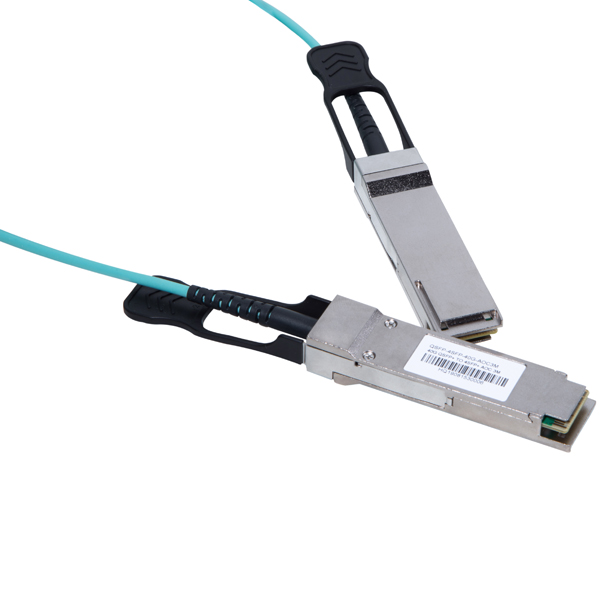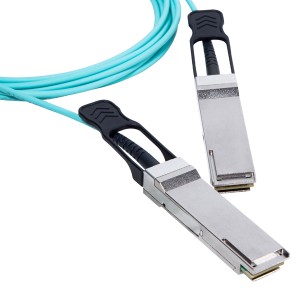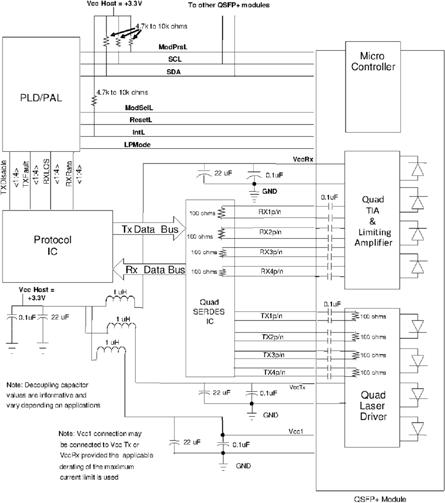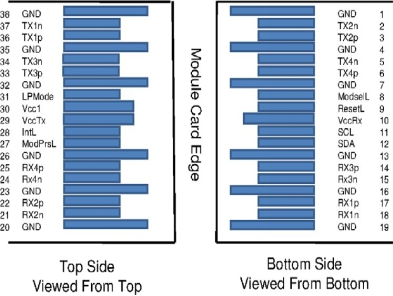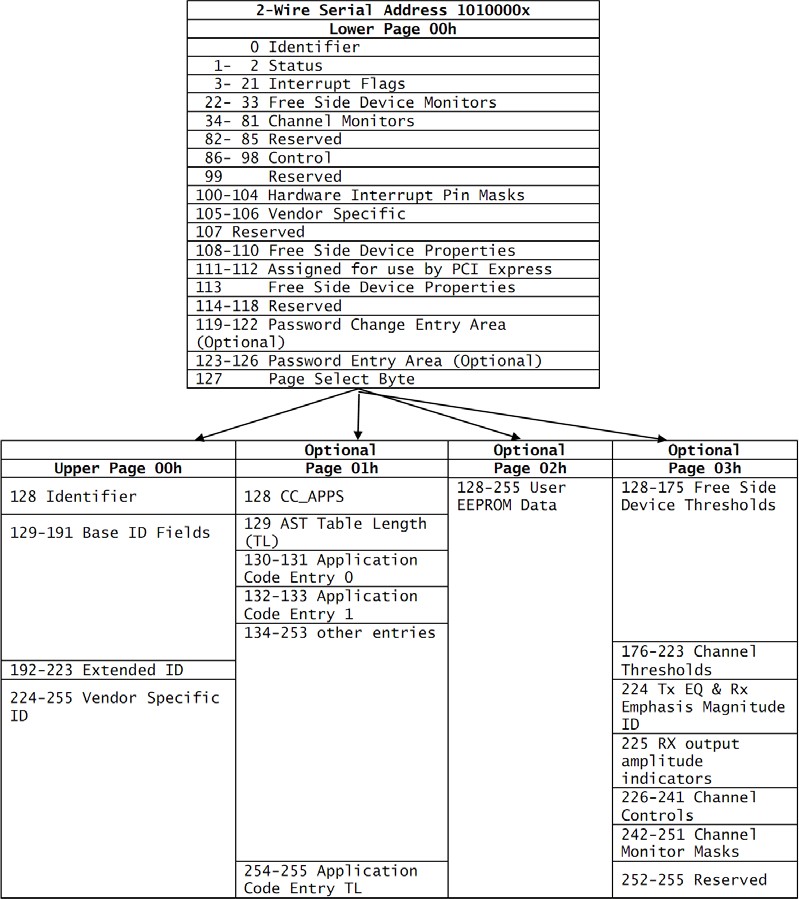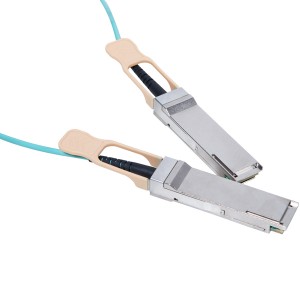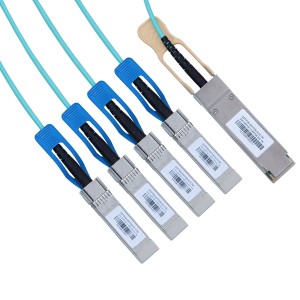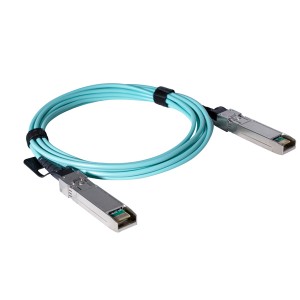40G QSFP+ Active optical cable JHA-QSFP-40G-AOC
Features
◊ Support 40GBASE-SR4/QDR application
◊ Compliant to QSFP+ Electrical MSA SFF-8436
◊ Multi rate of up to 10.3125Gbps
◊ +3.3V single power supply
◊ Transmission distance up to 300m
◊ Low power consumption
◊ Operating case temp Commercial: 0°C to +70 °C
◊ UL certification cables (optional)
◊ RoHS compliant
Applications
◊ 40GBASE-SR4 at 10.3125Gbps per lane
◊ InfiniBand QDR
◊ Other optical links
Specification:
Absolute Maximum Ratings
Table 1- Absolute Maximum Ratings
| Parameter | Symbol |
Min. |
Typical | Max. | Unit | Notes |
| Supply Voltage | Vcc3 |
-0.5 |
- | +3.6 | V | |
| Storage Temperature | Ts |
-10 |
- | +70 | °C | |
| Operating Humidity | RH |
+5 |
- | +85 | % | 1 |
Note: 1 No condensation
Recommended Operating Conditions
Table 2- Recommended operating Conditions
| Parameter | Symbol | Min. | Typical |
Max. |
Unit | Notes |
| Operating Case Temperature | TC | 0 | - |
+70 |
°C | |
| Power Supply Voltage | Vcc | 3.14 | 3.3 |
3.47 |
V | |
| Power dissipation | Pd | - | - |
1.5 |
w |
1 |
| Bit rate | BR | 1.25 | 10.3125 |
- |
Gbps |
|
Note: 1 Per terminal
Electrical Characteristics
Table 3- Electrical Characteristics
| Parameter | Symbol | Min. | Typ. | Max. | Units | Notes | |
| ModSelL | Module Select | VOL | 0 | - | 0.8 | V | |
| Module Unselect | VOH | 2.5 | - | VCC | V | ||
| LPMode | Low Power Mode | VIL | 0 | - | 0.8 | V | |
| Normal Operation | VIH | 2.5 | - | VCC+0.3 | V | ||
| ResetL | Reset | VIL | 0 | - | 0.8 | V | |
| Normal Operation | VIH | 2.5 | - | VCC+0.3 | V | ||
| ModPrsL | Normal Operation | VOL | 0 | - | 0.4 | V | |
| IntL | Interrupt | VOL | 0 | - | 0.4 | V | |
| Normal Operation | VoH | 2.4 | - | VCC | V | ||
|
Electrical transmitter Characteristics |
|||||||
| Differential Date Input Swing | Vout | 200 | - | 1600 | mV | ||
| Output Differential Impedance | ZD | 90 | 100 | 110 | Ω | ||
| Electrical Receiver Characteristics | |||||||
| Differential Data Output Swing | Vin,P-P | 350 | - | 800 | mVPP | ||
| Bit Error Rate | BER | E-12 | 1 | ||||
| Input Differential Impedance | ZIN | 90 | 100 | 110 | Ω | ||
Note: 1 PRBS2^31-1@10.3125Gbps
Recommended Interface Circuit
Figure 1, Recommended Interface Circuit
Pin arrangement
Figure 2, Pin View
Table 4-Pin Function
Definitions
|
Pin |
Symbol | Name/Description | Notes |
|
1 |
GND | Ground | 1 |
|
2 |
Tx2n | Transmitter Inverted Data Input | |
|
3 |
Tx2p | Transmitter Non-Inverted Data Input | |
|
4 |
GND | Ground | 1 |
|
5 |
Tx4n | Transmitter Inverted Data Input | |
|
6 |
Tx4p | Transmitter Non-Inverted Data Input | |
|
7 |
GND | Ground | 1 |
|
8 |
ModSelL | Module Select | |
|
9 |
ResetL | Module Reset | |
|
10 |
Vcc Rx | +3.3V Power Supply Receiver | |
|
11 |
SCL | 2-wire serial interface clock | |
|
12 |
SDA | 2-wire serial interface data | |
|
13 |
GND | Ground | 1 |
|
14 |
Rx3p | Receiver Non-Inverted Data Output | |
|
15 |
Rx3n | Receiver Inverted Data Output | |
|
16 |
GND | Ground | 1 |
|
17 |
Rx1p | Receiver Non-Inverted Data Output | |
|
18 |
Rx1n | Receiver Inverted Data Output | |
|
19 |
GND | Ground | 1 |
|
20 |
GND | Ground | 1 |
|
21 |
Rx2n | Receiver Inverted Data Output | |
|
22 |
Rx2p | Receiver Non-Inverted Data Output | |
|
23 |
GND | Ground | 1 |
|
24 |
Rx4n | Receiver Inverted Data Output | |
|
25 |
Rx4p | Receiver Non-Inverted Data Output | |
|
26 |
GND | Ground | 1 |
| 27 | ModPrsL | Module Present | |
| 28 | IntL | Interrupt | |
| 29 | Vcc Tx | +3.3V Power supply transmitter | |
| 30 | Vcc1 | +3.3V Power supply | |
| 31 | LPMode | Low Power Mode | |
| 32 | GND | Ground |
1 |
| 33 | Tx3p | Transmitter Non-Inverted Data Input | |
| 34 | Tx3n | Transmitter Inverted Data Input | |
| 35 | GND | Ground |
1 |
| 36 | Tx1p | Transmitter Non-Inverted Data Input | |
| 37 | Tx1n | Transmitter Inverted Data Input | |
| 38 | GND | Ground |
1 |
Note: 1. Circuit ground is internally isolated from chassis ground.
Monitoring Specification
Figure 3, Memory Map
Mechanical
Unit mm
Figure 4, Mechanical Diagram
Table 5- Cable
Length
| Cable Length L(Unit: m) | Tolerant(Unit: cm) |
| ≤1.0 | +5/-0 |
| 1.0<L≤4.5 | +15/-0 |
| 4.5<L≤14.5 | +30/-0 |
| >14.5 | +2%/-0 |
Warnings
Handling Precautions: This device is susceptible to damage as a result of electrostatic discharge (ESD).
A static free environment is highly recommended. Follow guidelines according to proper ESD procedures.
Laser Safety: Radiation emitted by laser devices can be dangerous to human eyes. Avoid eye exposure to direct or indirect radiation.

